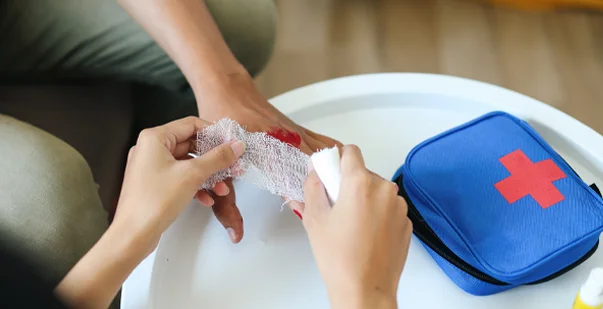
Last Updated on: August 1, 2024
When we give first aid, we often touch blood or other body fluids. These can carry germs that make us sick. Some common infections that can spread during first aid are:
Infections can spread in different ways when we’re helping someone. Here are the main ways:
Read More: The Main Objectives and Goals of First Aid Training
Staying safe while helping others is important. Only when you are safe, can you provide service to others. What is the best approach to lowering the risk for infection when giving first aid care? Here are some methods to prevent exposure or contamination-
Sometimes, even when we’re careful, accidents happen. If you come into contact with someone’s blood or body fluids:
What is your risk of getting infected when giving first aid care? Different types of first aid have different risks. Let’s look at some common situations:
CPR (Cardiopulmonary Resuscitation): When doing CPR, you might worry about catching germs from the person’s mouth. you might ask what is your risk of getting infected with a disease while giving first aid care? Studies say that the risk is very low. They suggest doing chest compressions without rescue breaths if you’re worried. Using a face shield or mask can also help keep you safe.
Wound Care: When taking care of cuts or scrapes, there’s a higher chance of touching blood. Always wear gloves and be careful not to touch your face. If possible, let the person clean their own wound while you guide them.
Helping Someone Who Is Throwing Up: Vomit can carry lots of germs. Wear gloves and a mask if you’re helping someone who is throwing up. Try to stay to the side to avoid any splashes.
Nosebleeds: Nosebleeds involve blood, so there’s a risk of infection. Have the person hold their own nose if they can. If you need to help, wear gloves and avoid touching the blood.
Read More: CPR Success Rate: How Effective Is CPR?
What is your risk of catching a disease when giving first aid care? The risk of infection can be different depending on where you’re giving first aid. Here are some things to think about in different places:
At Home: When helping family members, the risk is usually lower because you already share many germs. But it’s still good to use gloves and wash your hands.
At Work: Many workplaces have first aid kits and rules about giving first aid. Make sure you know where the supplies are and what the rules are.
In Public: When helping strangers, be extra careful. You don’t know their health history. Always use protective gear if you have it.
In Nature: If you’re camping or hiking, you might not have gloves or other supplies. In this case, try to use what you have (like plastic bags) to create a barrier. Clean up as best you can afterward.
Being ready before an emergency happens can help lower the risk of infection. No matter how you decide to help the victim, you must be thinking about how you can lower your risk for infection when giving breaths or other first aid. Here are some ways to prepare:
Giving first aid is a brave and kind thing to do. But it is not wise to do so without considering your own safety. By understanding the risk of infection while giving first aid and taking steps to protect yourself, you can help others without putting your own health in danger.